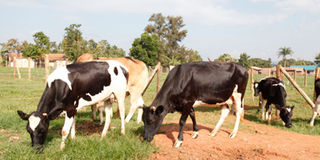Quick guide to set up a cattle farm

Dairy cattle feeding in a paddock in Luweero. photo by lominda afedraru
What you need to know:
- Livestock farming is one of the most rewarding animal rearing business anyone can engage in anywhere in Uganda, writes Lominda Afedraru.
- Dr Halid Kirunda, the director Mbarara Zonal Agricultural Research and Development Institute (MBAZARDI), explains that starting a livestock farm depends on the capital you intend to invest and having a wide knowledge on the best practices.
There has been rapid global expansion of production and consumption of animal products which is expected to continue to grow.
While traditional livestock systems contribute to the livelihoods of 70 per cent of the world’s rural poor, increasingly the emerging large scale operations with sophisticated technology and international trade cater for the rapidly growing markets for meat and milk.
Livestock production currently accounts for one third of the global crop land which is used to produce feed for animals and competes for land, water, energy and labour which is being challenged by the fancies of climate change and socio economic pressure. The sector according to Food and Agriculture Organisation contribute 40 per cent of the global value of agricultural output and support the livelihoods and food security of more than 1.3 billion people globally.
Dr Halid Kirunda, the director Mbarara Zonal Agricultural Research and Development Institute (MBAZARDI), explains that starting a livestock farm depends on the capital you intend to invest and having a wide knowledge on the best practices.
Good breeds
Dr Kirunda explains that for a farmer intending to rare good breeds of cattle, it is important to determine the purpose for producing livestock which in most cases is for dairy and beef production. Dr Kirunda says the following steps must be observed by the farmers to the letter.
•A farmer must determine how many animals can be accommodated on a specific piece of land.
•The different breed recommended for farmers in Uganda are Friesian cattle, Jersey, Ayrshire, Fleckvieh and Brown Swiss.
•A farmer wishing to breed cattle for purposes of obtaining ghee must rear Friesians and Jersey which produce less milk but full of fat.
•A farmer who is targeting much milk production has to go for the rest of the cow breed apart from the two.
•During the breeding process it is important to determine the mating period. The recommended practice is to use a healthy bull and artificial insemination mainly to avoid spread of diseases.
•Farmers must be keen and check when the animals are on heat but there is also the scientific method of inducing animals to come of heat to effect artificial insemination.
•Cows which are on heat usually stand stiff with swollen vulva and virginal discharge ready to be mounted.
•But for Friesian breeds, they are silent in showing signs of being on heat therefore a farmer must be on the lookout signs early morning and in the evening when the weather is cool.
•In conducting artificial insemination, this must be done 10 hours after detecting the cow is on heat.
Feed management
Dr Kirunda contends that a farmer who is aiming at feeding his cattle at all times must determine availability of pasture and other additional nutritional feeds. According to Dr Kirunda the following are some of the steps a dairy farmer must put in practice;
•The pasture can be on an established farm meant for growing pasture or improve on the existing pasture by planting improved grass and legume species.
•It is important to plant legumes such as Lablab, Calliandra and Centrosome and grass species such as brachiaria mulato, Rhodes grass, Napier grass and Chloris gayana.
•It is important to graze the animals at the right time usually early morning and in the evening and a farmer must establish the number of animals a pasture land can hold throughout the year.
•It is important to have at least four paddocks in a pasture land and animals must be fed from one paddock to another to enable regeneration of consumed pasture.
•In each paddock there must be a water facility for the animals and the recommended accessible distance is 100 metres.
•It is good to divide the paddocks into age groups, make sure calves, winning animals, heifers, first delivery cows and animals in lactation have separate paddocks.
•Heifers which are fed on high protein food will become too fat and consequently become infertile.




